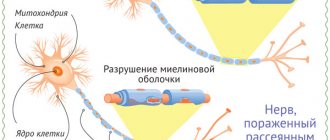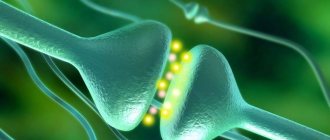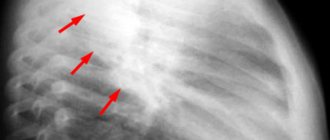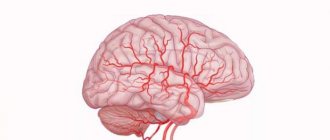Multiple sclerosis (MS) is a chronic pathology in which multiple lesions occur in the nervous system, both central and peripheral, characterized by steady deterioration.
The disease can affect people of any age category, mainly affecting young women from 20 to 40 years old.
In countries with harsher climates, the disease is more common. The incidence decreases in the direction from north to south.
What are the causes of multiple sclerosis in men and women (including young people), what causes it, how does it develop and is it transmitted, how long do sick people with this diagnosis live, and is it possible to die from this disease? Answers to questions are further in the article.
Causes
The disease develops slowly and is almost impossible to stop.
More than half of patients with 15-20 years of “experience” stop walking, sitting, and lose vision. The basis of multiple sclerosis is a disorder of the immune system, which consists in the fact that its security cells, once in the brain, have a destructive effect on the myelin of nerve fibers.
At the site of such exposure, scarring of the nervous tissue occurs, which loses its functions. As a result, there is a failure in the supply of impulses from the brain to the organs, the patient’s coordination of movements and speech are impaired, and he loses sensitivity.
According to modern concepts, multiple sclerosis is a multifactorial disease, that is, it is based on a combination of several causes simultaneously.
The following factors are considered the most important:
- viral infection;
- hereditary (genetic) predisposition of the immune system;
- geographical features of the place of permanent residence.
Viral infection
The causes of multiple sclerosis lead to damage to nerve fibers. Prerequisites for the launch of autoimmune processes:
- Age factor. The disease affects adults and children, however, statistics show that the pathology most often manifests itself in old age (after 50 years).
- Hereditary factor. It has been established that MS in rare cases is inherited with a low probability.
- Frequent worries, stress.
- After suffering from severe infectious diseases.
- Lack of vitamin D in the body.
- Poor environmental conditions.
Scientists note that rarely does one factor provoke the development of MS. Most patients are exposed to several provoking factors at once, as a result of which the disease overtakes them.
A number of factors cause the blood-brain barrier to increase its ability to allow immune cells to pass through. The function of this barrier is to protect brain antigens from the influence of the body’s own immune cells.
When this function is impaired, more T-lymphocytes are able to enter the brain, which provoke an inflammatory process.
Inflammation in the brain destroys the myelin sheath of the nerve because immune cells in the brain perceive the myelin sheath as a foreign body.
It is no longer possible to fully receive nerve impulses, so a person begins to feel the symptoms of multiple sclerosis.
There can be many reasons for this condition:
- viruses;
- chronic intoxication;
- poor nutrition;
- psycho-emotional stress;
- stress;
- injuries;
- heredity;
- oral contraceptives;
- elevated blood sugar levels.
Etiology of the disease in men and women
Where does multiple sclerosis come from? The main cause of multiple sclerosis is considered to be genetic predisposition.
The disease is inherited through several genes that determine the characteristics of human immunity . Their combinations may be different, but whether the disease will manifest itself depends on environmental factors.
Moreover, not only the disease itself can be inherited, but also its course, which is confirmed by the fact that there are familial cases of multiple sclerosis; in some families the fulminant course predominates, in others it is slowly progressive.
Many people, having heard about this disease or encountered it, wonder whether multiple sclerosis is contagious. From the above it follows that this disease is not contagious, as it is of a genetic nature.
What causes multiple sclerosis? The main predisposing factors causing the development of the disease:
- Infectious:
- Viruses - a viral infection often acts as a trigger for the onset of the disease. The specific “causal” virus has not yet been found, but retroviruses (human immunodeficiency virus (HIV), Rous sarcoma virus) are attracting the attention of scientists.
- Chronic bacterial infections - intestinal dysbiosis, foci of chronic tonsillitis, support excessive activity of the immune system.
- Frequent acute bacterial infections are another cause of multiple sclerosis.
- Could Candida Cause Multiple Sclerosis? Yes, fungal infections indicate a violation of both local and general immunity, which causes a decrease in resistance to infections, which become a trigger for the development of MS.
- Non-infectious:
- Geographic - the disease is more common in cold countries, and it has been noted that people who moved to warmer countries before the age of 14 are less susceptible to multiple sclerosis than their peers who remained in their homeland. If you migrate after 14 years of age, the risk of getting sick does not decrease.
Most researchers associate this with low levels of vitamin D in the body of people living in countries with harsh climatic conditions.There are even maps showing the risk of developing this disease depending on the latitude of where you live.
Environmental - this pathology more often develops in residents of cities, especially megacities, than in people living in rural areas. People living near heavy metal deposits are at high risk of getting sick.
- Geographic - the disease is more common in cold countries, and it has been noted that people who moved to warmer countries before the age of 14 are less susceptible to multiple sclerosis than their peers who remained in their homeland. If you migrate after 14 years of age, the risk of getting sick does not decrease.
- Racial - Europeans are most susceptible to this disease.
- Iron overload - People with gene mutations characteristic of multiple sclerosis tend to have increased levels of free iron in their brain tissue. Iron in large quantities is toxic to brain cells; depending on the part where it was deposited, convulsions, speech, vision and hearing disorders, and mental disorders occur.
- Psychosomatics of multiple sclerosis - childhood traumas are of great importance, accompanied by feelings of helplessness and insecurity, suppressed feelings of anger, living with “toxic” relatives, low self-esteem, reluctance to take control of one’s own life, shifting responsibility to others, fear of the past.
- Hormonal - the hormonal background has a significant impact on the functioning of the immune system; with an unstable profile of sex hormones, the general background is disrupted (and this is either a young age, when the hormonal system is formed and stabilizes, or an elderly age, when it fades), immunity is also unstable. Also, multiple sclerosis often manifests itself in women during menopause - when the female body is especially vulnerable.
In most clinical cases, it is not possible to identify the true cause of the development of pathology.
In the early stages of development, diagnosis is difficult due to a blurred clinical picture. The video will tell you about some of the causes of multiple sclerosis:
Classification
Classification of multiple sclerosis by localization of the process:
- The cerebrospinal form - statistically more often diagnosed - is distinguished by the fact that foci of demyelination are located in both the brain and spinal cord already at the onset of the disease.
- Cerebral form - according to the localization of the process, it is divided into cerebellar, brainstem, ocular and cortical, in which different symptoms are observed.
- Spinal form - the name reflects the location of the lesion in the spinal cord.
The following types are distinguished:
- Primary progressive – characteristic constant deterioration of the condition. Attacks may be mild or not pronounced. Symptoms include problems with walking, speaking, seeing, urinating, and bowel movements.
- The secondary progressive form is characterized by a gradual increase in symptoms. The appearance of signs of multiple sclerosis can be traced after a cold or inflammatory diseases of the respiratory system. Increased demyelination can also be observed against the background of bacterial infections, leading to increased immunity.
- Relapsing-remitting. Characterized by periods of exacerbation, which are followed by remission. During remission, complete restoration of the affected organs and tissues is possible. Does not progress over time. It occurs quite often and practically does not lead to disability.
- Remitting-progressive multiple sclerosis is characterized by a sharp increase in symptoms during periods of attacks, starting from the early stage of the disease.
Classification of multiple sclerosis
Doctors distinguish 4 types:
Clinically isolated syndrome - signs of the disease appear once and last for at least a day.- Relapsing sclerosis - symptoms appear progressively. This form is present in 85% of patients.
- Primary progressive type - deterioration of the condition begins gradually, there are no early relapses or remissions.
- Secondary progressive sclerosis - after the appearance of initial relapses or remissions, the disease begins to develop steadily.
Clinical signs
The first signs of multiple sclerosis are nonspecific and often go unnoticed by both the patient and the doctor. In most patients, the onset of the disease is manifested by symptoms of pathology in one system, and later others become involved.
Throughout the disease, exacerbations alternate with periods of complete or relative well-being
The first sign of multiple sclerosis appears at the age of 20-30 years. But there are cases when multiple sclerosis manifests itself both at an older age and in children. According to statistics: women appear more often than men.
Signs of multiple sclerosis according to frequency of manifestation are presented in the table.
How long do they usually live?
The life expectancy of a person with multiple sclerosis will depend on the following circumstances:
- timely diagnosis and initiation of treatment;
- concomitant diseases;
- possible complications.
The disease can affect people between the ages of 45 and both men and women (rarely children). In people over 50 years of age, the disease is diagnosed much less frequently.
According to statistics, if people with multiple sclerosis begin to experience complications in the form of limited movement after 50 years, their life expectancy does not exceed 70 years.
In addition, statistical data state that when this pathology is diagnosed, in general, the life of a sick person is reduced by 7 years . Do people die from this disease? Yes, this is possible, but a lot depends on the form of the disease and its stage.
Attention! With the right treatment, it is possible to live with the diagnosis, and sometimes it does not really change the quality of life.
Life expectancy to some extent depends on the patient himself.
Symptoms
Multiple sclerosis has a slow, progressive course. The initial stage of the disease is practically unnoticed by a person, and symptoms are absent or mild. The disease manifests itself when half of the nerve fibers have already been destroyed.
Doctors identify the following characteristic symptoms:
- Double vision and pain in the eyes;
- Decreased visual performance;
- Numbness of the limbs;
- Weakness of muscle tone;
Life with a diagnosis of multiple sclerosis can be successful if the patient takes the first symptoms seriously. However, waiting for recovery and not taking action, or self-medicating, will result in severe symptoms:
- Partial paralysis of the limbs;
- Involuntary urination and uncontrollability of bowel movements;
- Severe physical fatigue;
- Inconsistency of movements, it becomes difficult for a person to perform the assigned motor task;
- Neuroses accompanied by a severe state of depression and apathy towards the environment.
The disease has a wave-like course - regression and remission occur suddenly.
The quality and length of life depend on the patient. When making a diagnosis and studying thematic literature, a person falls into a depressive state and refuses to live.
If a person is negligent in treating a disease, this leads to disability. The patient will not be able to get out of a chair or bed and loses self-care skills.
But if a person is struggling, then statistics show how long one can live with good treatment:
- When the patient comes in at the initial stage of the disease, when the nerve fibers are partially affected, the life expectancy reaches 40 years.
- 15 years after the diagnosis of MS, 25% retain their work skills and are able to care for themselves.
- 75% of those sick become disabled.
No matter how frightening these statistics are, 10-15 years of a full life is motivation to undergo treatment.
The disease does not bypass celebrities.
They didn’t give up and continued therapy:
- Jack Osbourne (younger son of musician Ozzy Osbourne)
- writer Yuri Tynyanov, current NBA player Chris Wright
- First Lady of the United States - Anne Romney
And these are not all famous people diagnosed with multiple sclerosis, however, they find the strength to live on, which means you can too.
For each new patient, the first signs of the disease can be completely different. This is due to the fact that lesions of the central nervous system can be located in different places.
And the individuality of the symptoms depends on where exactly the source of inflammation is localized. Disturbances in the form of the first signs of the disease can affect any neurological area: motor, mental or sensitive.
You can suspect the development of multiple sclerosis if the following signs appear:
- muscle weakness;
- impaired coordination of movements;
- trembling of limbs;
- tremor;
- asynergy, in which it is difficult for a person to perform combined movements;
- spasms;
- difficult to move limbs;
- tingling, burning, pins and needles sensations or numbness in the arms and legs;
- nystagmus;
- double vision;
- the image is unclear;
- reduced picture brightness;
- color distortion and contrast disturbance;
- epileptic seizures;
Pathogenesis
The immunopathogenesis of multiple sclerosis consists of the following mechanisms:
- Immune, including autoimmune reactions - immune regulation in this disease is disrupted, immunity is activated by a viral or any other infection, trauma, stress, immune cells are fixed on the blood-brain barrier, changing its permeability.
The autoimmune component is rather secondary, since when the myelin sheaths disintegrate, the cells of the immune system perceive the cells of the nervous system as “foreign” and infect them. - Blood-brain barrier - in patients with MS, its permeability is increased, cells of the immune system pass through it (normally - not), causing inflammation of the brain substance and demyelination of nerve fibers. Iron also passes through it, depositing in the brain tissue and having a toxic effect on it.
- Demyelination is inflammation of nerve fibers with the breakdown of their myelin sheath. Myelin is a protein that covers the nerve fiber and accelerates the speed of impulse transmission along it many times. Later, loss of this protein leads to brain atrophy.
- Remyelination is the process of myelin restoration that occurs together with demyelination. Unfortunately, this already slow process slows down even more as the disease progresses.
Recent studies show that the diagnosis of multiple sclerosis is practically never found among HIV patients.
This can be explained by the fact that the diseases are opposite to each other. In multiple sclerosis, the immune system is hyperactive and even affects one’s own cells (nerve cells), while in HIV, immunity is reduced .
The human immunodeficiency virus is a retrovirus, and if we assume that one of the causes of multiple sclerosis is retroviral infections, perhaps antiretroviral therapy used for AIDS will also be effective for MS.
Basic diagnostic methods
Many neurological ailments have a similar etiology, so recognizing multiple sclerosis is not so easy. Timely diagnosis and prescribed treatment can help maintain normal health for a long time.
Differential diagnosis to identify this pathology:
- examination by a neurologist;
- a history of at least two signs of multiple sclerosis lasting more than 24 hours and a month interval between them;
- blood test (to exclude other diseases with similar symptoms);
- examination of cerebrospinal fluid to determine brain infections, as well as the level of white blood cells and immunoglobulins;
- MRI (magnetic resonance imaging) - although it is the main research method for this ailment, it does not provide an accurate picture of the disease, because the same changes in the structure of the brain can be caused by other ailments;
- determination of bioelectrical activity of the brain.
When the first symptoms of brain or nerve dysfunction appear, you should consult a neurologist. Doctors use special diagnostic criteria to determine multiple sclerosis:
- The presence of signs of multiple focal lesions of the central nervous system - the white matter of the brain and spinal cord;
- Progressive development of the disease with the gradual addition of various symptoms;
- Instability of symptoms;
- Progressive nature of the disease.
Clinical course
The pathogenesis of MS is based on autoimmune damage to the cells of the myelin (fatty) sheath of axons (the long processes of the nerve cell along which impulses are transmitted).
Normally, the myelin sheath of CNS axons is formed by oligodendrocytes, and in the spinal cord - by Schwann cells. It does not conduct impulses, but has interruption areas - nodes of Ranvier, along which the impulse “jumps”, acquiring greater speed.
In MS, autoimmune damage occurs to the cells that form myelin. The areas of the “bare” axon become longer and the passage of the nerve signal slows down significantly, and with sclerosis it stops completely. This is the basis for the varied clinical picture of the disease.
The first signs of multiple sclerosis in women are expressed in the appearance of symptoms such as:
- increased fatigue,
- unsteady gait
- low mood and depression,
- decreased sensitivity in the limbs,
- blurred vision, nystagmus, development of retrobulbar optic neuritis,
- dysarthria - blurred speech,
- dysphagia – difficulty swallowing, choking,
- ataxia – difficulty controlling balance,
- lethargy, spasms and cramps in the arms and legs,
- leg pain,
- intestinal dysfunction (constipation, diarrhea, flatulence),
- urinary dysfunction, urinary incontinence,
- decreased sex drive.
Symptoms are quite nonspecific and in rare cases are analyzed together. The patient does not pay attention to the signs for a long time or receives treatment for another disease. This is due to the fact that the initial stage often remains unrecognized.
The advanced stage of the disease is characterized by:
- paresis in the proximal limbs, the severity of which decreases in the supine position,
- damage to the cerebellum - impaired coordination of movements, difficulties with assessing distances, handwriting becomes large and sweeping, scanned speech, decreased tone, misses during coordination tests,
- increased reflexes and expansion of reflexogenic zones,
- decrease or complete disappearance of skin abdominal reflexes,
- pathological reflexes from the feet and hands, their clonus (large-scale trembling),
- the appearance of violent crying, laughter,
- headaches are accompanied by flashing “spots” before the eyes, nausea, and can occur as a migraine,
- sensitivity disorders, pain, tingling and numbness in various areas, menstrual irregularities,
- decreased visual acuity, damage to the oculomotor and optic nerves,
- a peculiar reaction to heat exposure, even when eating hot food - a short-term deterioration of the condition.
In the later stages, radiculopathy develops and back pain begins to bother you. Tonic convulsions, attacks of irresistible drowsiness, erratic movements of the limbs, neuroses, hysteria, depression or euphoria, decreased cognitive abilities, even dementia, may also occur.
Treatment
Reference. Despite the fact that multiple sclerosis cannot be completely cured, a specific therapeutic regimen has been developed that can prevent attacks, alleviate symptoms and change the course of the disease.
Neurologists select an individual treatment regimen for each patient. This is done taking into account the symptoms and specifics of the disease.
Is it possible to get rid of the disease?
In 2020, there is no drug to cure MS. Drug therapy is aimed at slowing the progression of the disease and eliminating the symptoms that are tormenting the patient.
For multiple sclerosis, the following groups of drugs are prescribed:
- Corticosteroids, which are aimed at reducing inflammation in the brain. This type of medication is used to avoid exacerbating manifestations of multiple sclerosis and life expectancy increases. Only a qualified doctor should prescribe such drugs, since this group has a wide range of side effects and is not used for long-term use.
- Drugs aimed at slowing the progression of MS (interferons beta).
- Medicines that combat symptomatic manifestations.
How long do they live with this diagnosis? Scientists presented the latest developments in drugs that allow patients to increase life expectancy. Physiotherapeutic treatment has proven effectiveness: Magnetic laser and decimeter wave irradiation.
Therapy is aimed at reducing symptoms and stopping the progression of multiple sclerosis.
Patients in whom the disease is diagnosed for the first time are usually hospitalized in the neurological department of the hospital for a detailed examination and treatment. Treatment is selected individually, depending on the severity and symptoms.
Multiple sclerosis is currently considered incurable. However, people are shown symptomatic therapy, which can improve the patient’s quality of life.
He is prescribed hormonal medications and drugs to enhance immunity. Sanatorium-resort treatment has a positive effect on the condition of such people.
All these measures can increase the time of remission.
Drugs that help change the course of the disease:
- drugs from the group of steroid hormones - this type of drug is used for exacerbations of multiple sclerosis, their use can reduce the duration of the period of its exacerbation;
- immunomodulators - with their help, the symptoms characteristic of multiple sclerosis are weakened and the time period of exacerbations increases;
- immunosuppressants (drugs that suppress immunity) - their use is dictated by the need to influence the immune system, which damages myelin during periods of exacerbation of the disease.
Symptomatic treatment is used to relieve specific symptoms of the disease. The following drugs can be used:
- Mydocalm, sirdalud - reduce muscle tone with central paresis;
- Prozerin, galantamine - for urinary disorders;
- Sibazon, phenazepam - reduce tremor, as well as neurotic symptoms;
- Fluoxetine, paroxetine - for depressive disorders;
- Finlepsin, antelepsin - used to eliminate seizures;
- Cerebrolysin, nootropil, glycine, B vitamins, glutamic acid are used in courses to improve the functioning of the nervous system.
A patient with multiple sclerosis will benefit from therapeutic massage. This will improve blood circulation and speed up all processes in the problem area. Massage will relieve muscle pain, spasms and improve coordination. However, this therapy is contraindicated in osteoporosis.
Acupuncture is also used to alleviate the patient's condition and speed up recovery. Thanks to this procedure, spasms and swelling are relieved, muscle pain is reduced and problems with urinary incontinence are eliminated.
With your doctor's permission you can take:
- 50 mg vitamin thiamine twice daily and 50 mg B-complex;
- 500 mg of natural vitamin C 2-4 times a day;
- folic acid in combination with B-complex;
- Twice a year for two months they take thioctic acid - an endogenous antioxidant that is involved in carbohydrate and fat metabolism.
Traditional methods of treating multiple sclerosis:
- 5 g of mumiyo is dissolved in 100 ml of boiled chilled water, taken on an empty stomach, a teaspoon three times a day.
- Mix 200 g of honey with 200 g of onion juice, consume one hour before meals 3 times a day.
- Honey and onions. You need to grate the onion and squeeze the juice out of it (you can use a juicer). A glass of juice should be mixed with a glass of natural honey. This mixture should be taken three times a day an hour before meals.
Unfortunately, there are no methods today that would completely cure multiple sclerosis. But there are drugs used to reduce the frequency of manifestations of the disease and ease their course.
There are also medications that delay the progression of the disease.
Drugs that help change the course of the disease:
- steroid hormones, which are prescribed in order to reduce the manifestations of exacerbations and the duration of this period;
- immunomodulators, which weaken the symptoms of the disease, with their help the interval between exacerbations becomes longer;
- immunosuppressants that can suppress a person’s immunity are prescribed during periods of exacerbations in order to reduce myelin damage.
In addition to the listed drugs, patients are prescribed medications for the symptomatic treatment of the disease.
To reduce the appearance of weakness, overheating should be avoided. So, you cannot stay under the sun for a long time, or visit steam rooms and baths.
Additionally, to eliminate this symptom, Fluoxetine or Amantadine is prescribed. If the patient, in addition to weakness, shows signs of depression, then it is rational to take the first drug.
The influence of psychological factors on life expectancy
It has been noted that frequent stress is one of the risk factors for multiple sclerosis.
At the same time, a stressful situation can not only affect the onset of the disease, but also “bring it back to life” during a period of relative remission.
American scientists from Northwestern University Feinberg School of Medicine (Chicago) conducted a study that showed that among people trained in stress management techniques, in 77% of cases new lesions do not form.
At the same time, among ordinary patients who have not been trained in special psychological techniques, new lesions do not form in only 55%.
Another common accompaniment of multiple sclerosis is depression. True, it acts as its consequence, not its cause. 25% of all people suffering from multiple sclerosis need the help of a psychiatrist for this reason; naturally, the total number of people suffering from depression is much higher. The risk of suicide increases by 7.5 times compared to the national average; about 15% of patients with multiple sclerosis and depression take their own lives.
Thus, the correct psychological attitude can not only improve the quality of life, but also stop the development of the disease, and falling into a state of despondency can reduce efforts to prolong the patient’s life to zero.
Prevention
Prevention of multiple sclerosis includes:
- Constant physical activity is required. They should be moderate, not debilitating.
- If possible, you need to avoid stress and find time to relax. A hobby will help you take your mind off problems.
- Cigarettes and alcohol accelerate the destruction of neurons and can cause damage to the immune system.
- Monitoring your weight, avoiding strict diets and overeating.
- Avoidance of hormonal medications (if possible) and contraceptives.
- Refusal of large amounts of fatty foods;
- Avoid overheating.
Diagnostics
It is not often possible to detect the disease at an early stage. An MRI is usually performed when the onset of pathology is pronounced.
Diagnostic methods
Making a diagnosis begins with analyzing complaints and collecting anamnesis. A general and neurological examination of the patient is also performed. Other diagnostic methods:
- The gold standard is considered to be an MRI with contrast , which allows one to identify plaques and assess the dynamics of the patient’s condition.
- Evoked potentials are used as an additional method that allows you to determine the safety of pathways.
- Ophthalmological examination with mandatory fundus examination.
Electroneuromyography of the upper and lower extremities can be used as additional methods; general tests (blood and urine), blood biochemistry, and immunological reactions are also prescribed.
Differential diagnosis
Differential diagnosis of multiple sclerosis in men is carried out with the following pathologies:
- ADEM (acute disseminated encephalomyelitis);
- Balo concentric sclerosis;
- Devic's neuromyelitis optica;
- systemic vasculitis;
- sarcoidosis;
- brain tumors;
- syringomyelia;
- Whipple's disease;
- mitochondrial encephalopathies.
General description of the pathology
Experts still do not know the exact cause of multiple sclerosis.
Research has established that the basis of this pathology is a malfunction in the immune system. To fight external and internal aggressors, such as infections, protective cells destroy the myelin sheath. As a result, there is a failure in the conduction of impulses to organs from the brain. Initially, the patient only periodically feels tingling in the feet, hands, as well as slight numbness in these areas. But as the disease progresses, the symptoms become more pronounced, and the person’s condition worsens.
https://www.youtube.com/watch?v=prEaK_J_s-A
Medicine cannot give a clear answer to the question of how long people live with multiple sclerosis. You can live a full life with it if the symptoms are detected at an early stage of the disease. Much will also depend on the patient’s desire for recovery, as well as timely treatment.
But what do the statistics say about multiple sclerosis? How long do they live with him? As a rule, the life expectancy of patients who have been diagnosed with this disease is 10 years less. Since modern medical research and drugs make it possible to slow down the course of this pathological process occurring in the nervous system.
Causes of the disease
Multiple sclerosis remains to this day
According to scientists, it is an autoimmune disease. In other words, the human immune system becomes aggressive not only to external factors (viruses, bacteria, etc.), but also to the myelin sheaths of the nerves, that is, to the body’s own tissues, and damages them.
During the period of exacerbation of the disease, foci devoid of myelin appear in the white matter of the brain, the so-called
This continues until the next exacerbation occurs.
In addition to the white matter, other tissues are affected: nerve fibers (inside the myelin) and gray matter (nerve cell bodies).
The mechanism of their destruction is somewhat different: tissues age at a rapid pace. This process occurs both during exacerbation and during remission.
Genetic factors include a certain combination of genes that cause a disorder in the body's immune system.
There are also non-genetic factors. This may be stress, unfavorable living environment, poor nutrition, bacteriological or infectious diseases, smoking, frequent injuries, exposure to radiation and ultraviolet radiation.
The cause of multiple sclerosis may be a certain combination of external and internal factors that caused the disease.
There are risk factors that can trigger the development of multiple sclerosis:
- A certain area of residence or insufficient production of vitamin D. More often, multiple sclerosis affects people whose place of residence is located far from the equator. These are northern areas with insufficient sunlight. In such people, vitamin D is not produced in the required amount and can cause the development of sclerosis;
- Stressful situations, strong neuropsychic stress;
- Excessive smoking;
- Low uric acid levels;
- Received hepatitis B vaccine;
- Diseases caused by viruses or bacteria.
The causes of multiple sclerosis are numerous external and internal (including hereditary) factors.
External factors, when exposed to an organism with a genetically determined predisposition, can stimulate the development of demyelination of nervous tissue.
Various causative factors, both external and internal, can increase the permeability of the blood-brain barrier:
- back and head injuries
- physical and mental stress
- stress
- operations
Nutritional features, such as a large proportion of animal fats and proteins in the diet, have a significant impact on biochemical and immunological reactions in the central nervous system, forming a risk factor in the development of pathology.
Can treatment prolong life?
Neurologists at the Yusupov Hospital are developing comprehensive treatment programs for patients with this pathology, including drug treatment, physiotherapeutic procedures, exercise therapy and other methods. Highly qualified specialists daily help patients return to a full life, using deep knowledge, high-precision equipment and innovative methods.
Adequate therapy using effective means allows patients at the Yusupov Hospital to return to a full life. In addition, neurologists tell patients how to live with multiple sclerosis and what measures need to be taken to prolong the period of remission.
Contact neurologists to undergo a comprehensive diagnosis of the body. Appointments can be made by calling the Yusupov Hospital.
Neurologist, director of the chronic pain clinic
Life expectancy with multiple sclerosis is shortened, regardless of the form of the pathology. But you can live a long time if you deal with complications in time and take medications prescribed by the doctor. Many patients benefit from physiotherapy, exercise therapy and alternative methods of treatment, for example, Tibetan traditional medicine.
However, with MS there is a predilection for certain diseases:
- urinary incontinence or retention;
- respiratory and urinary tract infections;
- mental disorders, split personality;
- hypotension;
- poor health, depression, apathy;
- rare bouts of vigor and activity;
- wear and tear of the joints, the need for bed rest and, as a result, the appearance of bedsores;
- disorientation in space;
- sexual dysfunctions;
- muscle atrophy, tremor, convulsions.
It is possible to extend the life of patients with multiple sclerosis if you devote all your efforts to this: provide psychotherapeutic support and comfortable living conditions, regularly give prescribed medications, and monitor changes in health. If medical recommendations are followed, patients live from 25 to 40 years, with severe forms of the disease - up to 5-7 years.
MS therapy is divided into relieving exacerbations and interval treatment
There are currently no therapeutic methods that make it possible to completely stop the progression of the disease or cure it. This is due to the fact that scientists cannot fully understand the mechanism of its occurrence. Despite this, it is quite possible to extend the life of a person with multiple sclerosis by improving his condition, which leads to an increase in the quality of life.
How long can people live with multiple sclerosis if they follow doctor's instructions? First of all, drug therapy helps with the slow-onset form of the disease. Regular medications, periodic examinations, good nutrition, provision of proper and constant care and other measures - all together this will help prolong life for up to 30 years from the moment the pathology is detected.
For multiple sclerosis, therapy includes drugs that prevent exacerbations, provide a long period of remission, and reduce the rate of development of the disease. Symptomatic treatment is carried out.
Drugs that modify the course of multiple sclerosis help prevent exacerbations and reduce the severity of the disease:
- Interferons. Medicines in this group reduce the activity of lymphocytes, prevent their spread in the central nervous system, and reduce immune system cells in the affected area. The group includes Betaferon, Gilenia, Extavia, Avonex.
- Glatiramer acetate. With long-term use, the number of complications and their frequency decreases, reactions leading to the destruction of myelin are blocked.
- Immunosuppressants. Medicines in this group are aimed at suppressing the immune response. These are Prednisolone from the glucocorticosteroid series, Cyclosporine, Sirolimus.
- Monoclonal antibodies. Aimed at removing antigens that are not characteristic of humans. Used by Tysabri.
During exacerbation
In case of exacerbation, glucocorticosteroid drugs are used. This is Dexamethasone, Prednisolone. Methylprednisolone may be administered intravenously.
At the same time, ascorbic acid is prescribed - it is involved in the synthesis of glucocorticosteroids. Etisizol leads to activation of the pituitary gland and an increase in the content of the hormone in the blood.
Alternatively, intravenous immunoglobulins are administered or plasmapheresis is performed. The latter method is aimed at purifying the blood of antibodies and toxins.
To reduce the severity of symptoms, antidepressants are prescribed. This group includes Amitriptyline and Fluoxetine. Their purpose is to regulate the content and balance of neurotransmitters, in particular dopamine, serotonin and norepinephrine.
Anticonvulsant medications are used. They reduce convulsive phenomena and pain. Some of them simultaneously have a sedative effect. Phenobarbital, Acediprol, Amizepine are used.
Muscle relaxants reduce muscle tension and eliminate spasms. Mydocalm and Baclofen are used.
Nootropic drugs help improve mental activity, memory, and attention. At the same time, they have a calming effect. Medicines: Nootropil, Pantogam, Glycine.
Additionally, medications are prescribed to relieve dizziness, incontinence, and constipation.
Recently, alternative treatment methods have been used. They include the use of stem cells, immunosorption.












